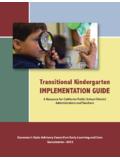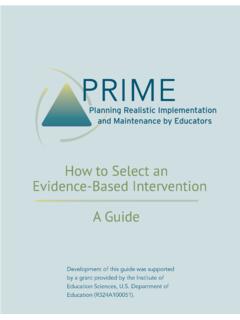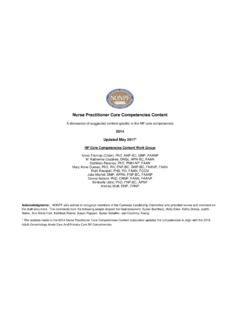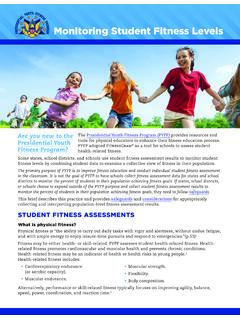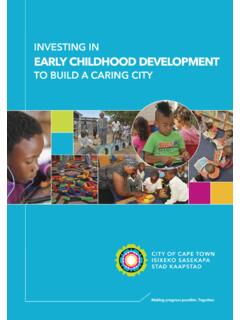Transcription of Student Success Through Instructional Leadership Liisa ...
1 42 BU Journal of Graduate Studies in Education, Volume 8, Issue 2, 2016 Student Success Through Instructional Leadership Liisa Brolund Abstract Instructional Leadership is a model of school Leadership in which a principal works alongside teachers to provide support and guidance in establishing best practices in teaching. Principals employing this model of Leadership communicate with their staff and together set clear goals related to Student achievement. In this model, teachers are supported by the principal. The principal provides coaching and mentoring to those teachers who require it, as well as professional development opportunities that allow teachers to explore best practices in teaching. The goal of Instructional Leadership is for the principal to work closely with teachers in order to increase Student achievement.
2 The leader of a school has a high level of responsibility to students , teachers, parents, and the community. Classroom teachers need a leader who will be supportive, motivating, and knowledgeable. A well-rounded principal will have a varied style of Leadership that will draw on many different Leadership models. One model, Instructional Leadership , is a pathway for setting and communicating a clear vision and goals for teachers and students , and supporting teachers Through coaching, mentoring and professional development (Robinson, Lloyd, & Rowe, 2008). When a principal is an Instructional leader, there are positive outcomes in Student achievement (Hansen & L ruds ttir, 2015; Rigby, 2013; Robinson et al., 2008). Strong Instructional leaders can therefore have a positive effect on Student outcomes and learning in their schools. The goal of the Instructional Leadership model is to promote Student learning (Carraway & Young, 2014 ; duPlessis, 2013).
3 In order to promote Student learning, principals who enact Instructional Leadership will have a clear vision for their school and will communicate this vision to their staff (McEwan, 2003). Additionally, principals who are Instructional leaders support teachers to improve their practice by giving them access to the resources that they require, coaching and mentoring them, and providing professional development opportunities, both formal and informal. Instructional leaders act as an Instructional resource to support teachers in order to improve their teaching practice. Instructional Leadership does not come without challenges, and principals reported that they do not have enough time and knowledge to be effective Instructional leaders or that they are uncomfortable commenting on teachers classroom practices (Salo, Nyland, & Stjernstr m, 2014 ).
4 Principals who use these tenets of Instructional Leadership have increased potential to improve teaching and learning in the school. Vision and Goals Developing and communicating a clear vision about the direction of the school is one of the critical tasks of an Instructional leader. Principals are required to build a vision for improving Student achievement, and they expect that teachers will accept the vision and apply it consistently in their classrooms (duPlessis, 2013). Establishing a vision and setting goals will help to steer the school toward higher Student achievement. When principals establish goals for the school and communicate these goals to the staff, teachers will work together for a common cause. For example, Principals in Greece do not usually discuss goals and visions for the school with their staff; however, in high performing schools, principals see themselves as visionaries and discuss goals with the teachers (Kaparou & Bush, 2015).
5 Despite the traditional exam-based Greek system, having a clear vision motivates the teachers to create an environment in which students enjoy learning (Kaparou & Bush, 2015). Communicating the vision and goals to the staff helps to inspire trust, spark motivation, and empower teachers and students to do their very best ( Four Instructional BU Journal of Graduate Studies in Education, Volume 8, Issue 2, 2016 43 Leadership Skills, 2015). In order to improve Student learning, an Instructional leader will have a vision for the school and will communicate it clearly to his/her staff. In order to improve Student learning, the content of the goals is important. Instructional leaders develop goals that set high standards for Student achievement (McEwan, 2003). Instruction and Student achievement are central to school goals in high-performing schools (Graczewski, Knudson, & Holtzman, 2009).
6 When these goals are clearly defined to teachers, the teachers are more likely to align their professional development activities and their own professional growth plans to the school goals. An Instructional leader develops and communicates a vision and goals for his/her school, which sets high standards for Student achievement. Supporting Teachers Teachers are on the front lines of schools, working with the students every day. Instructional Leadership means that principals provide support for teachers in their teaching practice, professional development, and resource management (duPlessis, 2013; Hansen & L ruds ttir, 2015; Salo et al., 2014 ). Additionally, principals should be an Instructional resource in their school ( Four Instructional Leadership Skills, 2015). In supporting teachers and encouraging them to improve their teaching practice continuously, principals who are also Instructional leaders positively affect Student learning.
7 In order for teachers to teach students effectively, it is necessary that they have access to both formal and informal professional development opportunities. Principals of high-performing schools encourage teachers to attend professional development sessions beyond the ones mandated by the state (Kaparou & Bush, 2015). Facilitating professional development activities and encouraging teachers to take risks for innovation in their instruction also has positive effects on Student learning (duPlessis, 2013). An Instructional leader encourages and supports teachers to improve their teaching practices, leading to increased Student achievement. Instructional leaders provide coaching and mentoring for the teachers in their schools. Teachers who receive coaching are more likely to practise new skills and implement them in their classroom (Carraway & Young, 2014 ).
8 Teachers can learn a great deal from each other. Recognizing this opportunity, principals in some high-performing schools implement an informal strategy for teachers to work together on improving their teaching practices (Kaparou & Bush, 2015). This type of support enables the teachers to practise new skills in their classrooms and consolidate their learning from professional development sessions. Teachers require a variety of materials and resources in order to do their jobs effectively. Instructional leaders ensure that teachers have what they need in order to do the best possible job for students ( Four Instructional Leadership Skills, 2015). Along with material things, teachers require knowledge and access to people with the expertise to deliver the knowledge. An Instructional leader recognizes that expertise can belong to many people and that it is their job to bring the experts together in order for teachers to have access to everything that they need (Graczewski et al.)
9 , 2009). Instructional leaders support teachers by providing them with the required resources, material and otherwise. Instructional leaders are an Instructional resource for their staff. As an Instructional resource, a principal keeps abreast on current trends in effective instruction, assessment, and curriculum ( Four Instructional Leadership Skills, 2015). Continuing to engage in their own professional development, principals can become Instructional resources to their staff. Providing direction and support that will improve teachers instruction is a main responsibility for an Instructional leader (duPlessis, 2013). This support can come in various forms, such as providing access to professional development opportunities, coaching and mentoring, managing resources, and the principal adopting the role of Instructional resource.
10 When teachers feel supported in their work, it has positive outcomes on Student learning. 44 BU Journal of Graduate Studies in Education, Volume 8, Issue 2, 2016 Challenges to Instructional Leadership Despite evidence that practicing Instructional Leadership in schools has a positive effect on Student achievement, many principals perceive roadblocks to becoming effective Instructional leaders. Principals have reported that they have little time to focus on Instructional tasks, they are uncomfortable visiting teachers classrooms, and they do not have the knowledge or capacity to guide teachers practice (Carraway & Young, 2014 ; Salo et al., 2014 ). In order to overcome these roadblocks, principals can become learners themselves and work alongside teachers to learn new curriculum , teach lessons to try out new skills, and seek out master teachers from whom to learn (McEwan, 2003).










